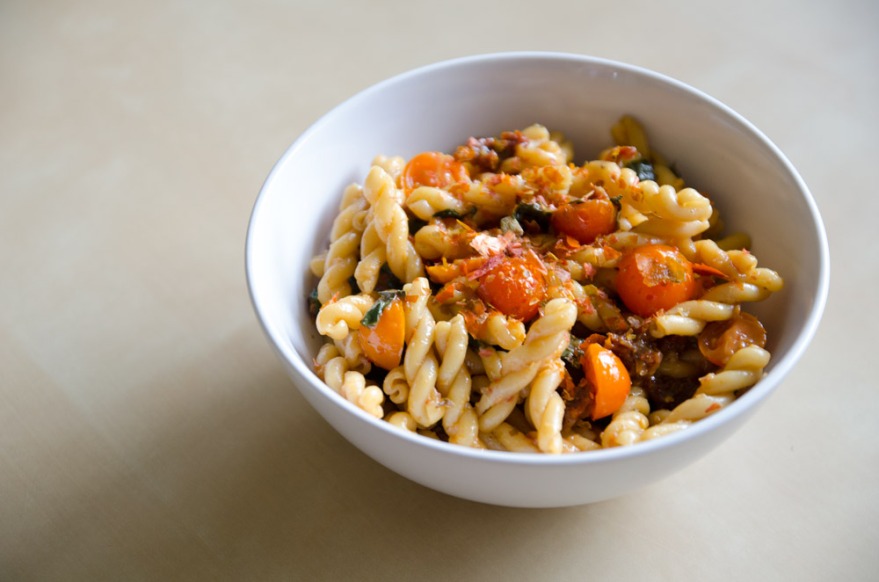My husband is not a picky eater, and I love to cook, so we have a very pleasant arrangement where I decide everything we eat and he happily goes along with it. It must be a strange experience to live as my husband does, though I wholeheartedly agree with the sentiment that while cooking is about control, eating is about submission. In that sense, it must be even stranger to live as I do, apart from nature, and in complete control of meal planning. My meals may be more or less seasonal, but I do not depend on what can be gathered and hunted. I simply design my pantry.
Being a CSA member is unique compared to American food culture because we tend to focus so heavily on choice. It’s your right to put whatever you want on your plate, idealists be damned. People can tell us all they want what we should eat, but all that matters is what we decide. Sugar and fat are so bad, but oh, oh so good.
Except perhaps its this choice that has made us so complacent and picky. Abundance is usually to blame for our dietary ills, but I’m beginning to think that choice has just as much to do with it. If pizza is your favorite, why ever eat anything that isn’t? There’s quite a bit of science on the matter of choice, and it really does paralyze us. What olive oil should we pick, if there are 20 to choose from? What mustard? Decision fatigue is a real thing, so each of these tiny choices add up to wear away at our will. Eventually we get tired of choosing. Eventually we just pick what’s easy, like the drive-thru.
All that being said, it was usually a relief to have a big box of vegetables chosen for me and then dropped in my lap each week. I say usually because I’m still not in love with radishes. But I cooked a lot of surprising things over the last 5 months, almost all of it things I might never have bothered to try. Eggplant probably enjoyed the most experimentation, but my main strategy wasn’t so much to experiment, as it was to prepare a lot of classic dishes that I had neglected due to the sheer vastness of things I want to eventually cook. These included ratatouille, corn and tomato salad (not exactly new but previously under-appreciated), celeriac roulade, chimichurri, pickled beets, pickled onions, and pumpkin soup. Outside of the CSA fare, I also tackled frozen yogurt, infused vinegars, shrubs, and a hell of a lot of canning projects, all while dabbling in urban foraging. None of this is exactly complicated or difficult, but it’s always the simplest things that are the easiest to fuck up. It’s also the simplest things that are the easiest to forget about.
Tomorrow will be the last pick up of the CSA season. I’m saddened it’s already over, but to celebrate everything Excelsior Farm has brought me, I’ve complied a list of some of my favorite recipes of the summer.
- Persian Eggplant and Tomato Stew
- Roasted Chickpea and Kale Salad with Sundried Tomato Vinaigrette
- Pink Greens
- Momofuku Pickled Beets and Alton Brown’s Pickled Beets
- Ratatouille (a guide)
- Carrot Top Pesto
- Kohlrabi and Apple Slaw
Marinated Eggplant
Adapted from The Canal House Cookbook, Vol. 8, Pronto!
- 1 large eggplant, small-ish dice
- ¼ cup each good quality olive oil and red wine vinegar
- 1 clove garlic, minced
- ½ tsp dried oregano
- salt and pepper to taste
Add the eggplant to boiling water, reduce heat and simmer until barely tender. The recipe calls for 1 inch dice, but I think a bit smaller would be more pleasing to spoon onto a slice of baguette. If you’d like a more “olive” type of dish, stick with the 1 inch dice.
Whisk the remaining ingredients into a dressing and toss with the drained eggplant. Cover and chill for 2 hours or overnight. Let sit at room temperature for 30 minutes or so before serving.
Dilly Garden Potato Salad
- red potatoes, 1 inch dice
- carrot, thinly sliced coins
- radishes, thinly sliced coins
- cucumber, thin half-moons or quarters
- mayo and sour cream (around 1:2 ratio)
- large bunch of dill, finely chopped
- a little lemon juice or white wine vinegar to thin the dressing
- salt and pepper to taste
Whisk the dressing ingredients (the last 4) together and set aside to marry. Boil the potatoes until easily pieced with a paring knife, being careful not to overcook. Toss with the carrot, radish, and cucumber in a large bowl. Pour the dressing over while the potatoes are still warm and toss to coat. Chill before serving.



















